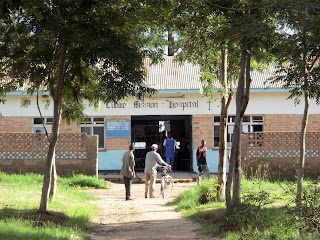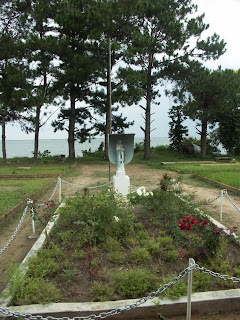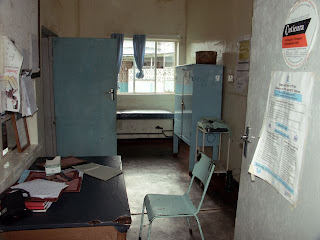The hospital is home to a large collection of the most basic equipment like the antiquated x-ray machine with a dark-room for developing films manually, an ultrasound machine from the 80s donated by some hospital in Japan, and a first aid room that looks more like a torture chamber than a place of healing. Among this medical equipment graveyard, there is an occasional brand-new machine like the newly arrived automated film development machine and the CD4 counter in the lab. I soon realize the limiting factor to the functioning of the hospital is electricity: when power is cut, which is very often, the x-ray machine doesn’t run and the lab cannot analyze bloods. There is a generator, but it is expensive to run and is only used during emergencies like when someone needs an emergency cesarean section.
The scary-looking first aid room
After orientation, I meet up with Dr. P., who only recently arrived at the hospital from the Democratic Republic of Congo. He takes me to the male ward and starts rounds. With twenty beds set two feet apart from one another, the ward does not offer any privacy for consultation. Every question we ask the patient is heard by everyone else. During examination, the patient is partially shielded from the other patients by a movable screen pushed around by the nurse. In the first two hours, I am already seeing my first cases of malaria, TB, and HIV. All the patients are from rural areas, most are uneducated and don’t speak any English, and by the looks of it, possess little more than the shirts on their backs. As the belief in witchcraft is still deeply held among the people, most patients have already seen witch doctors over the years before coming to hospital, as evidenced by the healed scars from cutting on various parts of the body that ailed them.

Male ward

George is one of the nurses
 A simply but ingenious design for a trolley: 1 piece of canvas, 2 poles, and 2 metal bars on top of a cart
A simply but ingenious design for a trolley: 1 piece of canvas, 2 poles, and 2 metal bars on top of a cartEntrance to outpatient clinic
After work, I decide to take advantage of the remaining daylight and walk to the lake. The guesthouse is next to a primary school. Soon I am surrounded by a group of kids wanting me to take their pictures. Smile!
Kids outside the Catholic church

















No comments:
Post a Comment